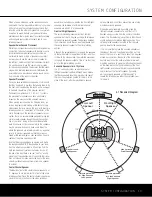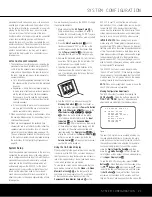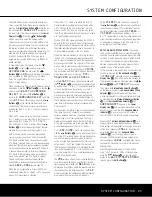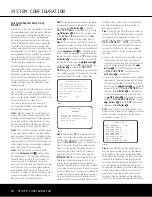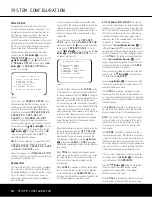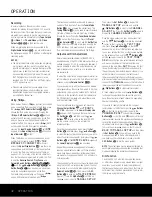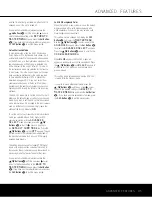
NOTE:
The subwoofer level is not adjustable when the
normal test tone is in use. The subwoofer output level
may be adjusted when the channel levels are being
trimmed to an external program source rather than the
test tone, as shown on page 42.
Using the Semi-OSD System
The output levels may also be adjusted at any time
using the remote control and semi-OSD system. To
adjust the output levels in this fashion, press the
Test
Button
i
. As soon as the button is pressed, the
test tone will begin to circulate as indicated earlier. The
correct channel from which the test noise should be
heard will be shown in the lower third of the video
screen and in the
Lower Display Line
Q
. While the
test noise is circulating, the proper channel position
will also be indicated in the
Speaker/Channel
Input Indicators
O
by a blinking letter within the
correct channel.
To adjust the output level, press the
⁄
/
¤
Buttons
n
until the desired level is shown in the display or
on screen. Once the buttons are released, the test
noise will begin to circulate again in 5 seconds.
When all channels have the same output level, press
the
Test Button
i
again to complete the process.
If you find that the output levels are either uncomfort-
ably low or high, you may repeat the procedure, but
first adjust the master volume either slightly higher or
lower (but not higher than 0dB) to compensate. Do
not adjust the volume during the procedure, as that will
cause the output levels to be higher or lower for only
some channels, resulting in uneven balance.
NOTE:
Output level adjustment is not available for the
VMAx or Surround Off modes.
Additional Input Adjustments
After one input has been adjusted for Surround mode,
digital input (if any) and speaker type, go back to the
INPUT SETUP
line on the
MASTER
MENU
(Figure 1) and enter the settings for each
input that you will use. In most cases, only the digital
input and surround mode will be different from one
input to the next, while the speaker type, crossover
frequency, Night mode and output level settings
will usually be the same and will automatically be
carried over when the previously configured surround
modes are selected. However, you will need to
reenter the delay and output level settings for each
surround mode.
When all settings and adjustments have been made,
press the
OSD Button
v
to return to normal
operation of the AVR.
Once the settings outlined on the previous pages have
been made, the AVR 340 is ready for operation. While
there are some additional settings to be made, these
are best done after you have had an opportunity to lis-
ten to a variety of sources and different kinds of pro-
gram material. These advanced settings are described
on pages 44–45 of this manual. In addition, any of
the settings made in the initial configuration of the unit
may be changed at any time. As you add new or dif-
ferent sources or speakers, or if you wish to change a
setting to better reflect your listening taste, simply fol-
low the instructions for changing the settings for that
parameter as shown in this section.
At this time, we recommend that you enter your sys-
tem’s settings into the worksheet provided on page 66
so that you may easily reenter the data in the event of
a power loss or for some other reason.
Having completed the setup and configuration process
for your AVR 340, you are about to experience the
finest in music and home theater listening. Enjoy!
SYSTEM CONFIGURATION 33
SYSTEM CONFIGURATION 33
SYSTEM CONFIGURATION
AVR 340 OM 3/22/06 9:09 AM Page 33
Summary of Contents for AVR 340
Page 67: ......

